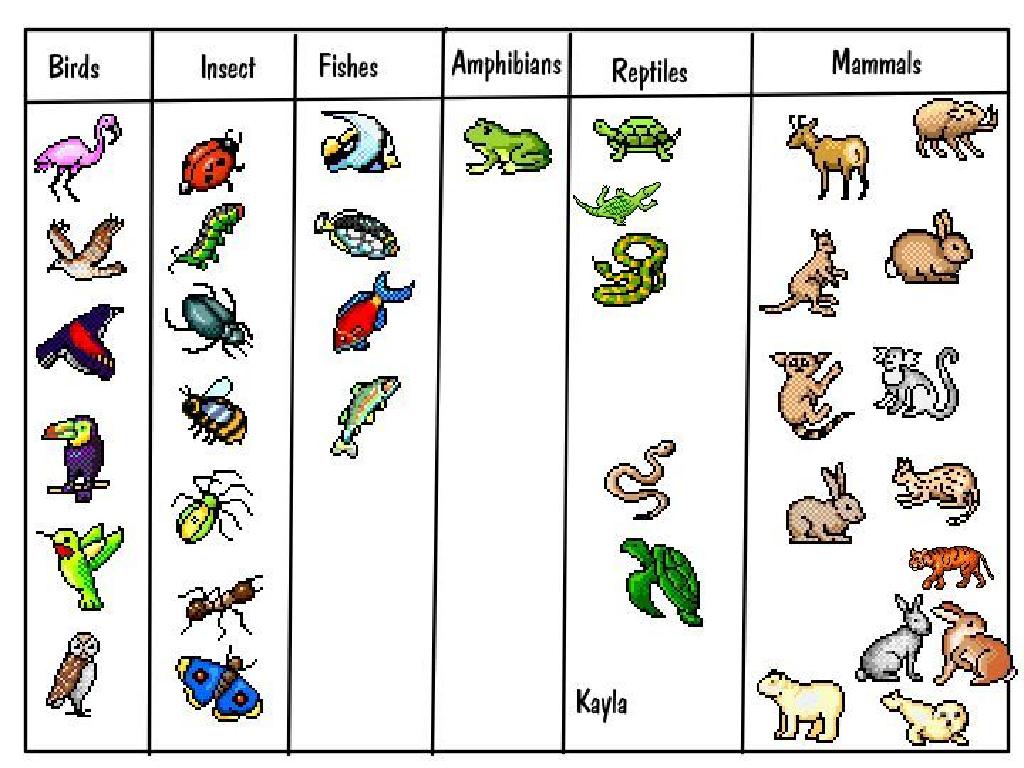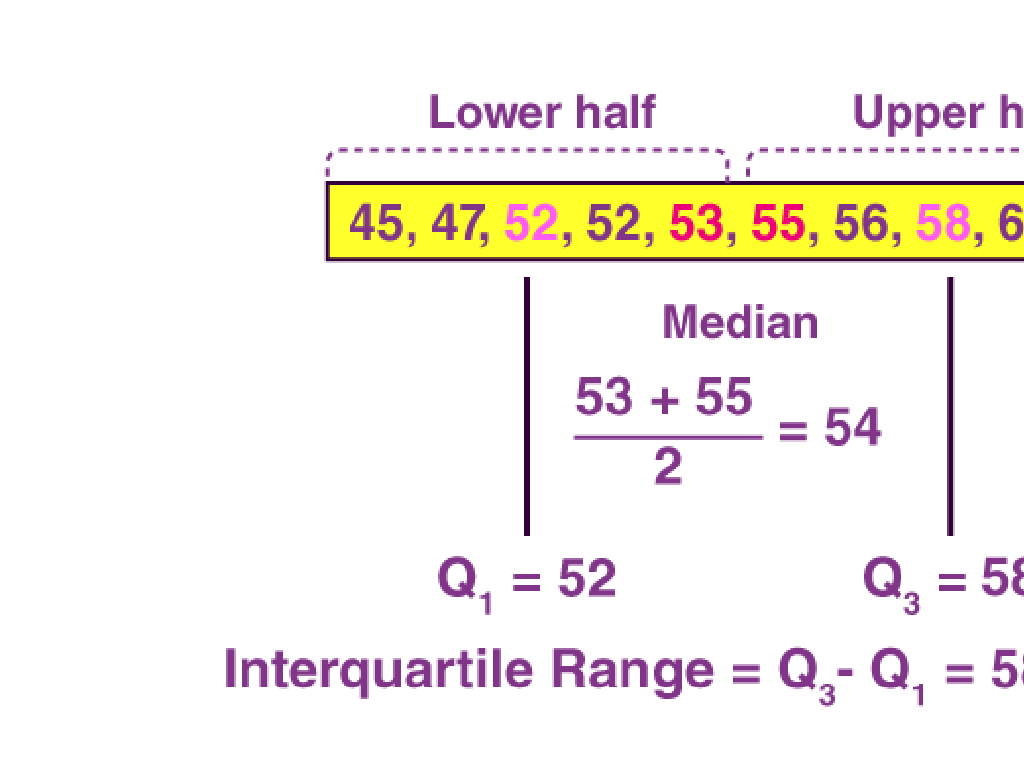Apply Addition, Subtraction, Multiplication, And Division Rules
Subject: Math
Grade: Eighth grade
Topic: Rational Numbers
Please LOG IN to download the presentation. Access is available to registered users only.
View More Content
Mastering Operations with Rational Numbers
– Define rational numbers
– Numbers expressed as a fraction of two integers, e.g., 1/2, 3/4, -5/6
– Rational numbers in daily life
– Used in finances, cooking, and time management
– Addition and subtraction rules
– Same denominator: add/subtract numerators. Different: find common denominator
– Multiplication and division rules
– Multiply numerators and denominators. Division: multiply by reciprocal
|
This slide introduces students to the concept of rational numbers and their practical applications in everyday life. Begin by defining rational numbers as any number that can be expressed as a fraction of two integers, where the denominator is not zero. Provide examples and non-examples. Discuss how these numbers are used in various real-life scenarios such as budgeting, measuring ingredients, and dividing time. Then, explain the rules for performing basic operations: addition and subtraction require a common denominator, while multiplication and division involve numerators and denominators. Emphasize the importance of understanding these operations to solve real-world problems. Encourage students to practice these rules with examples and prepare for more complex applications.
Exploring Rational Numbers
– Define rational numbers
– A number that can be expressed as a fraction a/b, where a and b are integers, and b is not zero.
– Examples vs. non-examples
– Examples: 1/2, -3/4; Non-examples: Pi, square root of 2
– Every integer is rational
– Integers like -2, 0, 7 can be written as -2/1, 0/1, 7/1
– Practical applications
|
Begin with the definition of rational numbers, emphasizing the condition that the denominator cannot be zero. Provide clear examples of rational numbers and contrast them with non-examples like irrational numbers to solidify understanding. Highlight that every integer is a rational number by showing how they can be expressed as fractions with a denominator of one. Discuss practical applications, such as measuring ingredients for a recipe or dividing a pizza among friends, to demonstrate the relevance of rational numbers in everyday life. Encourage students to think of other examples and to recognize rational numbers in various contexts.
Operations with Rational Numbers
– Adding & subtracting rationals
– Combine like terms; use number line for visualization
– Multiplying & dividing rationals
– Multiply numerators and denominators; reciprocate and multiply for division
– Order of operations matters
– Follow PEMDAS to solve expressions correctly
– Practice with examples
|
This slide introduces students to the fundamental operations with rational numbers, including addition, subtraction, multiplication, and division. Emphasize the use of a number line for addition and subtraction to help visualize the process, especially when dealing with negative values. For multiplication and division, remind students to multiply across for multiplication and to flip the second fraction (take the reciprocal) for division. Stress the importance of following the order of operations (PEMDAS: Parentheses, Exponents, Multiplication and Division, Addition and Subtraction) to ensure accurate results. Provide practice problems that require the application of these rules in various combinations to solidify understanding.
Adding and Subtracting Rational Numbers
– Find a common denominator
– Common denominator needed for like terms
– Add or subtract the numerators
– Keep the denominator, combine the numerators
– Simplify the resulting fraction
– Reduce fractions to simplest form
– Practice with examples
– Use examples to apply these steps
|
This slide introduces the process of adding and subtracting rational numbers, which are fractions or mixed numbers. Start by finding a common denominator, which is essential for combining these numbers. Once a common denominator is established, add or subtract the numerators while keeping the denominator the same. After combining the numerators, simplify the fraction to its simplest form. This may involve reducing the fraction or converting an improper fraction to a mixed number. Provide students with several examples to practice these steps, ensuring they understand each part of the process. Encourage them to work through problems and ask questions if they encounter difficulties.
Multiplying Rational Numbers
– Multiply numerators and denominators
– For fractions a/b and c/d, multiply to get (a*c)/(b*d)
– Cross-cancel to simplify
– Reduce fractions before multiplying to ease calculation
– Simplify the final product
– Always express the answer in simplest form
|
When teaching multiplication of rational numbers, start by explaining that the numerators and denominators are multiplied separately. Emphasize the importance of cross-canceling, which simplifies the fractions before multiplying, making calculations easier and reducing errors. After multiplication, guide students to simplify the product to its lowest terms. This could involve factoring out common factors or dividing by the greatest common divisor. Provide examples and practice problems to ensure students understand each step. Encourage students to always check their final answer for simplification, as this is a crucial skill in working with rational numbers.
Dividing Rational Numbers
– Dividing is multiplying by reciprocal
– To divide by a number, multiply by its reciprocal: a ÷ b = a × (1/b)
– How to find a reciprocal
– Reciprocal of a/b is b/a. For whole numbers, reciprocal of a is 1/a
– Steps to perform division
– Flip the divisor to its reciprocal, then multiply
– Practice with examples
|
When teaching division of rational numbers, emphasize that division is essentially multiplication by the reciprocal. Ensure students understand the concept of a reciprocal flipping the numerator and denominator of a fraction. For whole numbers, the reciprocal is simply 1 over the number. Walk through the steps of finding the reciprocal and then multiplying by it to perform division. Provide several examples with different types of rational numbers (fractions, whole numbers, mixed numbers) to illustrate the process. Encourage students to solve problems in pairs or groups to reinforce the concept.
Rules for Operations with Rational Numbers
– Keep-Change-Change for subtraction
– To subtract, keep the first number, change subtraction to addition, change the second number s sign.
– Cross-cancel before multiplying
– Simplify fractions first by cross-canceling common factors before multiplying.
– Divide by multiplying with reciprocal
– Instead of dividing fractions, multiply by the reciprocal of the divisor.
– Practice these rules with examples
|
This slide focuses on the fundamental rules for performing operations with rational numbers. When subtracting, students should remember ‘Keep-Change-Change,’ which means to keep the first number, change the operation from subtraction to addition, and then change the sign of the second number. For multiplication, it’s efficient to cross-cancel any common factors between numerators and denominators before multiplying to simplify the work. When dividing, teach students to multiply by the reciprocal of the second fraction instead of performing division directly. Provide examples for each rule to ensure understanding, such as 3/4 – 1/2, 2/3 * 4/5, and 5/6 ÷ 1/3. Encourage students to solve these problems using the rules and to check their answers. The next class will involve practice problems where students can apply these rules to various rational number operations.
Applying Operations to Rational Numbers
– Solve addition problems
– Add fractions like 3/4 + 2/3, find common denominators
– Work on subtraction examples
– Subtract numbers like 7/8 – 1/4, remember to simplify
– Practice multiplication with rationals
– Multiply examples: -3/5 * 2/7, keep an eye on the signs
– Divide and conquer division exercises
– Divide: 4/9 ÷ 2/3, don’t forget to multiply by the reciprocal
|
This slide is focused on engaging students with hands-on practice to solidify their understanding of arithmetic operations with rational numbers. Provide a variety of problems that require adding, subtracting, multiplying, and dividing fractions and mixed numbers. Encourage students to explain their reasoning for each step to reinforce their comprehension. As they work through the problems, remind them of key concepts such as finding common denominators, simplifying results, and the rules for operations with negative numbers. Offer guidance and support as needed, and consider pairing students for peer learning opportunities.
Class Activity: Rational Numbers Relay
– Form teams for the relay
– Each team solves a problem step
– One step of the problem per team member
– Complete the rational number problem
– Use addition, subtraction, multiplication, or division of rational numbers
– First team to finish wins
|
This activity is designed to encourage teamwork and reinforce the understanding of operations with rational numbers. Divide the class into small groups, ensuring a mix of abilities in each team. Provide each team with a multi-step problem involving rational numbers. Each member will solve one step of the problem, then pass it to the next member. The first team to solve the problem correctly wins. Possible activities: Team A adds fractions, Team B subtracts mixed numbers, Team C multiplies a fraction by a whole number, Team D divides a whole number by a fraction. Ensure that each student understands their operation before starting and remind them to check their teammates’ work for accuracy.
Wrapping Up: Operations with Rational Numbers
– Review of addition, subtraction, multiplication, and division rules
– Homework: Practice problem set
– Solve problems involving rational numbers to reinforce today’s lesson
– Encourage questions on today’s lesson
– Open floor for any clarifications needed
– Additional resources for further learning
– Suggest websites, books, and videos for extra practice
|
As we conclude today’s lesson on rational numbers, it’s important to summarize the key points and ensure students understand the rules for performing operations with these numbers. Assign a set of problems that cover all operations to solidify their learning. Encourage students to ask questions if they’re unsure about any part of the lesson; this promotes an open learning environment. Additionally, provide a list of resources such as educational websites, textbooks, and tutorial videos for students who may need extra help or wish to delve deeper into the topic. This will cater to different learning styles and help students become more confident in their math skills.






